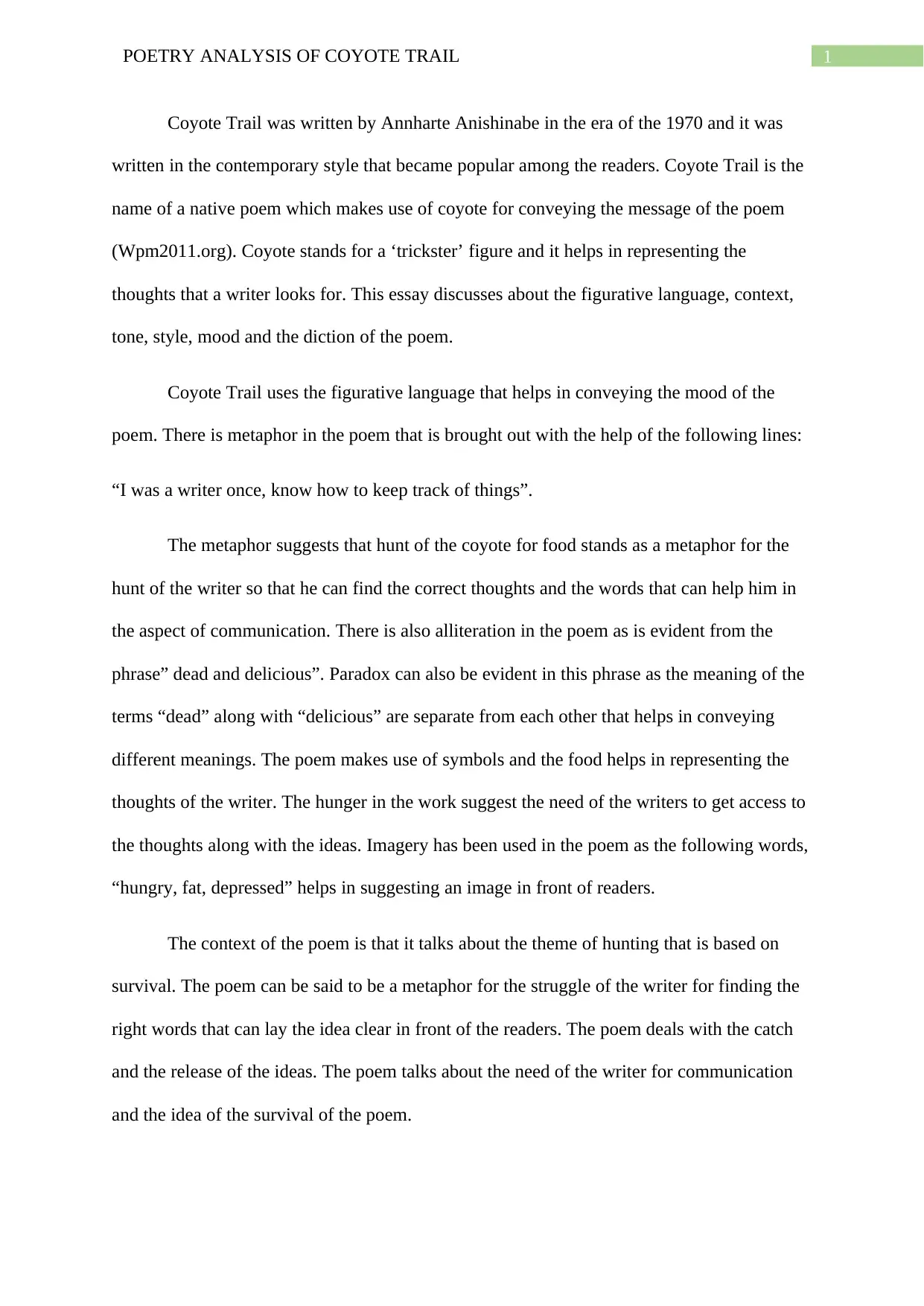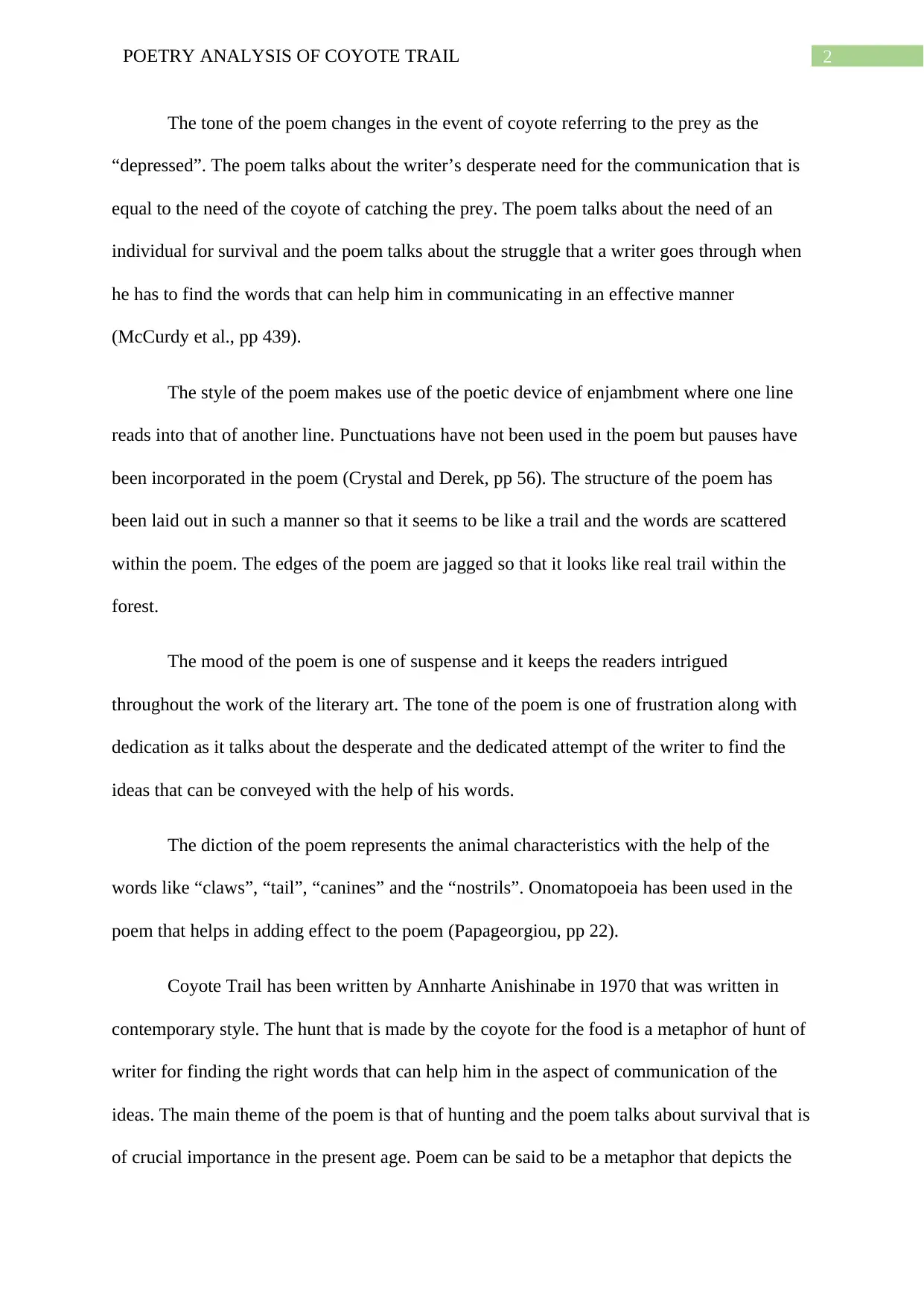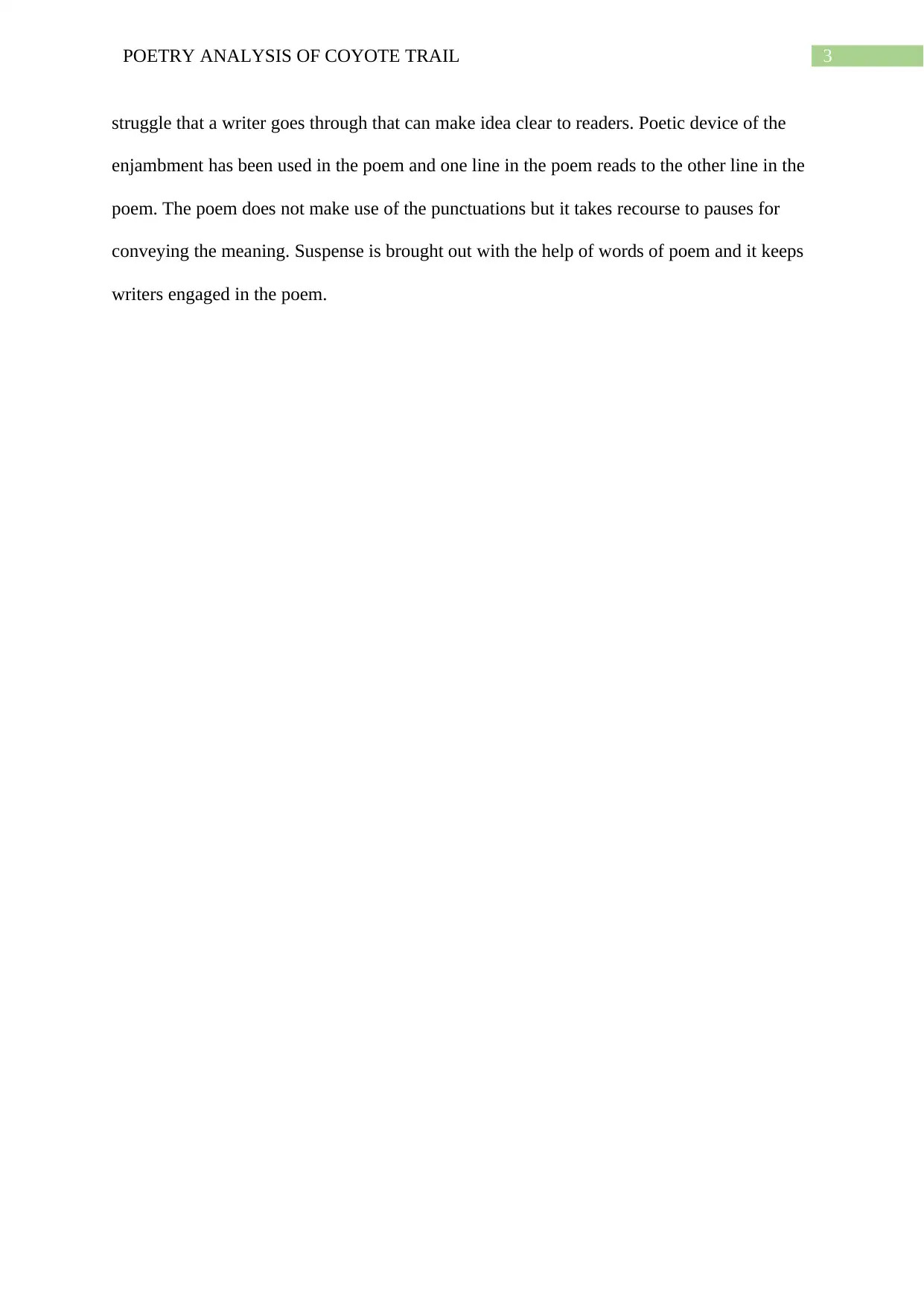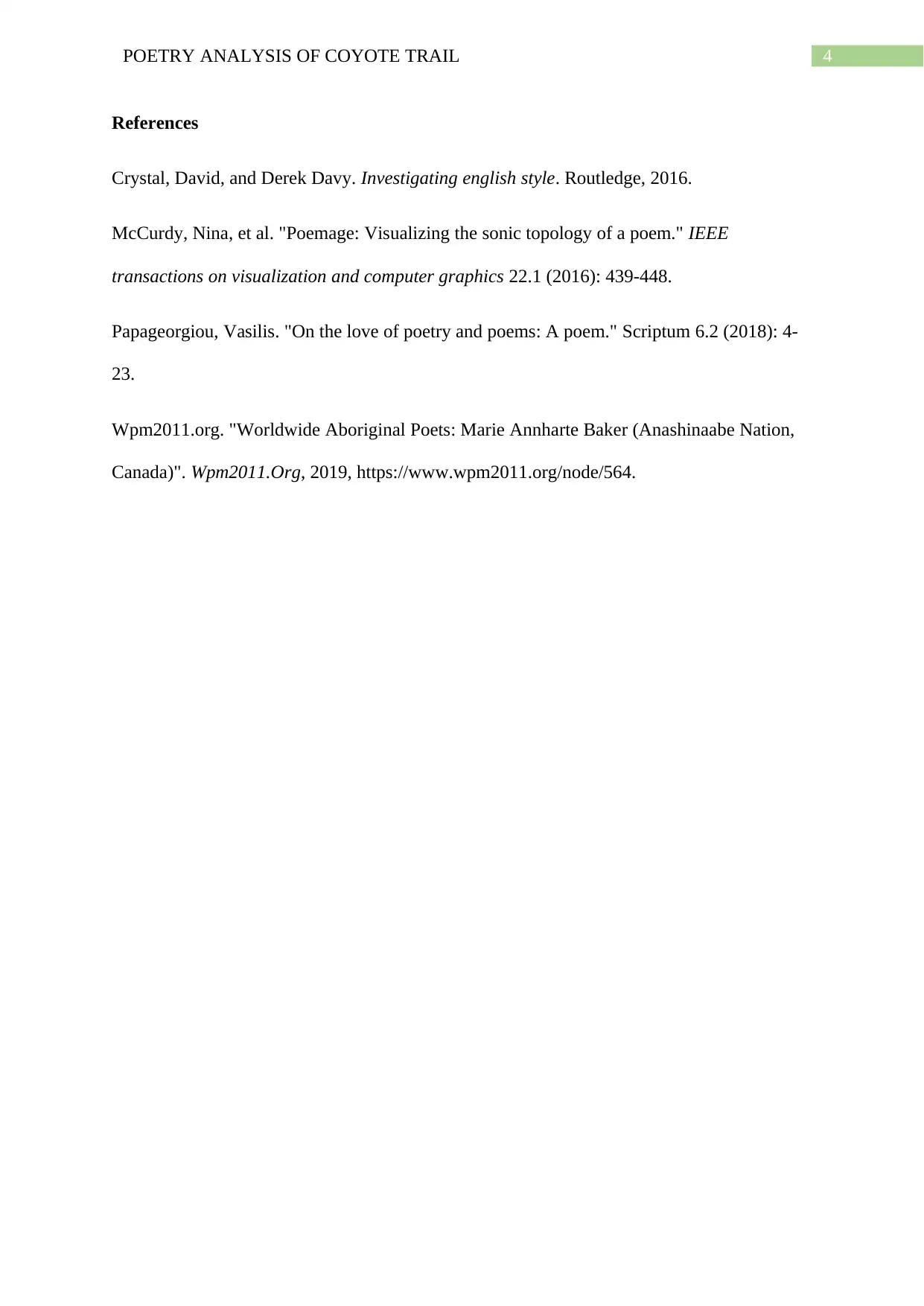In-depth Analysis of Coyote Trail by Annharte Anishinabe Poem
VerifiedAdded on 2023/04/23
|5
|1025
|175
Essay
AI Summary
This essay provides a detailed analysis of Annharte Anishinabe's poem, "Coyote Trail," written in the contemporary style of the 1970s. The poem uses the figure of the coyote as a trickster to explore themes of hunting, survival, and the writer's struggle for finding the right words to communicate ideas. The analysis covers figurative language such as metaphor, alliteration, paradox, symbols, and imagery, as well as the poem's context, tone, style, mood, and diction. The essay highlights the use of enjambment, pauses instead of punctuation, and the poem's structure to convey a sense of suspense and the writer's dedicated attempt to capture elusive ideas. The hunt of the coyote for food is presented as a metaphor for the writer's quest for the right words.

Running head: POETRY ANALYSIS OF COYOTE TRAIL
Poetry Analysis of Coyote Trail
Name of the student
Name of the University
Author note
Poetry Analysis of Coyote Trail
Name of the student
Name of the University
Author note
Paraphrase This Document
Need a fresh take? Get an instant paraphrase of this document with our AI Paraphraser

1POETRY ANALYSIS OF COYOTE TRAIL
Coyote Trail was written by Annharte Anishinabe in the era of the 1970 and it was
written in the contemporary style that became popular among the readers. Coyote Trail is the
name of a native poem which makes use of coyote for conveying the message of the poem
(Wpm2011.org). Coyote stands for a ‘trickster’ figure and it helps in representing the
thoughts that a writer looks for. This essay discusses about the figurative language, context,
tone, style, mood and the diction of the poem.
Coyote Trail uses the figurative language that helps in conveying the mood of the
poem. There is metaphor in the poem that is brought out with the help of the following lines:
“I was a writer once, know how to keep track of things”.
The metaphor suggests that hunt of the coyote for food stands as a metaphor for the
hunt of the writer so that he can find the correct thoughts and the words that can help him in
the aspect of communication. There is also alliteration in the poem as is evident from the
phrase” dead and delicious”. Paradox can also be evident in this phrase as the meaning of the
terms “dead” along with “delicious” are separate from each other that helps in conveying
different meanings. The poem makes use of symbols and the food helps in representing the
thoughts of the writer. The hunger in the work suggest the need of the writers to get access to
the thoughts along with the ideas. Imagery has been used in the poem as the following words,
“hungry, fat, depressed” helps in suggesting an image in front of readers.
The context of the poem is that it talks about the theme of hunting that is based on
survival. The poem can be said to be a metaphor for the struggle of the writer for finding the
right words that can lay the idea clear in front of the readers. The poem deals with the catch
and the release of the ideas. The poem talks about the need of the writer for communication
and the idea of the survival of the poem.
Coyote Trail was written by Annharte Anishinabe in the era of the 1970 and it was
written in the contemporary style that became popular among the readers. Coyote Trail is the
name of a native poem which makes use of coyote for conveying the message of the poem
(Wpm2011.org). Coyote stands for a ‘trickster’ figure and it helps in representing the
thoughts that a writer looks for. This essay discusses about the figurative language, context,
tone, style, mood and the diction of the poem.
Coyote Trail uses the figurative language that helps in conveying the mood of the
poem. There is metaphor in the poem that is brought out with the help of the following lines:
“I was a writer once, know how to keep track of things”.
The metaphor suggests that hunt of the coyote for food stands as a metaphor for the
hunt of the writer so that he can find the correct thoughts and the words that can help him in
the aspect of communication. There is also alliteration in the poem as is evident from the
phrase” dead and delicious”. Paradox can also be evident in this phrase as the meaning of the
terms “dead” along with “delicious” are separate from each other that helps in conveying
different meanings. The poem makes use of symbols and the food helps in representing the
thoughts of the writer. The hunger in the work suggest the need of the writers to get access to
the thoughts along with the ideas. Imagery has been used in the poem as the following words,
“hungry, fat, depressed” helps in suggesting an image in front of readers.
The context of the poem is that it talks about the theme of hunting that is based on
survival. The poem can be said to be a metaphor for the struggle of the writer for finding the
right words that can lay the idea clear in front of the readers. The poem deals with the catch
and the release of the ideas. The poem talks about the need of the writer for communication
and the idea of the survival of the poem.

2POETRY ANALYSIS OF COYOTE TRAIL
The tone of the poem changes in the event of coyote referring to the prey as the
“depressed”. The poem talks about the writer’s desperate need for the communication that is
equal to the need of the coyote of catching the prey. The poem talks about the need of an
individual for survival and the poem talks about the struggle that a writer goes through when
he has to find the words that can help him in communicating in an effective manner
(McCurdy et al., pp 439).
The style of the poem makes use of the poetic device of enjambment where one line
reads into that of another line. Punctuations have not been used in the poem but pauses have
been incorporated in the poem (Crystal and Derek, pp 56). The structure of the poem has
been laid out in such a manner so that it seems to be like a trail and the words are scattered
within the poem. The edges of the poem are jagged so that it looks like real trail within the
forest.
The mood of the poem is one of suspense and it keeps the readers intrigued
throughout the work of the literary art. The tone of the poem is one of frustration along with
dedication as it talks about the desperate and the dedicated attempt of the writer to find the
ideas that can be conveyed with the help of his words.
The diction of the poem represents the animal characteristics with the help of the
words like “claws”, “tail”, “canines” and the “nostrils”. Onomatopoeia has been used in the
poem that helps in adding effect to the poem (Papageorgiou, pp 22).
Coyote Trail has been written by Annharte Anishinabe in 1970 that was written in
contemporary style. The hunt that is made by the coyote for the food is a metaphor of hunt of
writer for finding the right words that can help him in the aspect of communication of the
ideas. The main theme of the poem is that of hunting and the poem talks about survival that is
of crucial importance in the present age. Poem can be said to be a metaphor that depicts the
The tone of the poem changes in the event of coyote referring to the prey as the
“depressed”. The poem talks about the writer’s desperate need for the communication that is
equal to the need of the coyote of catching the prey. The poem talks about the need of an
individual for survival and the poem talks about the struggle that a writer goes through when
he has to find the words that can help him in communicating in an effective manner
(McCurdy et al., pp 439).
The style of the poem makes use of the poetic device of enjambment where one line
reads into that of another line. Punctuations have not been used in the poem but pauses have
been incorporated in the poem (Crystal and Derek, pp 56). The structure of the poem has
been laid out in such a manner so that it seems to be like a trail and the words are scattered
within the poem. The edges of the poem are jagged so that it looks like real trail within the
forest.
The mood of the poem is one of suspense and it keeps the readers intrigued
throughout the work of the literary art. The tone of the poem is one of frustration along with
dedication as it talks about the desperate and the dedicated attempt of the writer to find the
ideas that can be conveyed with the help of his words.
The diction of the poem represents the animal characteristics with the help of the
words like “claws”, “tail”, “canines” and the “nostrils”. Onomatopoeia has been used in the
poem that helps in adding effect to the poem (Papageorgiou, pp 22).
Coyote Trail has been written by Annharte Anishinabe in 1970 that was written in
contemporary style. The hunt that is made by the coyote for the food is a metaphor of hunt of
writer for finding the right words that can help him in the aspect of communication of the
ideas. The main theme of the poem is that of hunting and the poem talks about survival that is
of crucial importance in the present age. Poem can be said to be a metaphor that depicts the
⊘ This is a preview!⊘
Do you want full access?
Subscribe today to unlock all pages.

Trusted by 1+ million students worldwide

3POETRY ANALYSIS OF COYOTE TRAIL
struggle that a writer goes through that can make idea clear to readers. Poetic device of the
enjambment has been used in the poem and one line in the poem reads to the other line in the
poem. The poem does not make use of the punctuations but it takes recourse to pauses for
conveying the meaning. Suspense is brought out with the help of words of poem and it keeps
writers engaged in the poem.
struggle that a writer goes through that can make idea clear to readers. Poetic device of the
enjambment has been used in the poem and one line in the poem reads to the other line in the
poem. The poem does not make use of the punctuations but it takes recourse to pauses for
conveying the meaning. Suspense is brought out with the help of words of poem and it keeps
writers engaged in the poem.
Paraphrase This Document
Need a fresh take? Get an instant paraphrase of this document with our AI Paraphraser

4POETRY ANALYSIS OF COYOTE TRAIL
References
Crystal, David, and Derek Davy. Investigating english style. Routledge, 2016.
McCurdy, Nina, et al. "Poemage: Visualizing the sonic topology of a poem." IEEE
transactions on visualization and computer graphics 22.1 (2016): 439-448.
Papageorgiou, Vasilis. "On the love of poetry and poems: A poem." Scriptum 6.2 (2018): 4-
23.
Wpm2011.org. "Worldwide Aboriginal Poets: Marie Annharte Baker (Anashinaabe Nation,
Canada)". Wpm2011.Org, 2019, https://www.wpm2011.org/node/564.
References
Crystal, David, and Derek Davy. Investigating english style. Routledge, 2016.
McCurdy, Nina, et al. "Poemage: Visualizing the sonic topology of a poem." IEEE
transactions on visualization and computer graphics 22.1 (2016): 439-448.
Papageorgiou, Vasilis. "On the love of poetry and poems: A poem." Scriptum 6.2 (2018): 4-
23.
Wpm2011.org. "Worldwide Aboriginal Poets: Marie Annharte Baker (Anashinaabe Nation,
Canada)". Wpm2011.Org, 2019, https://www.wpm2011.org/node/564.
1 out of 5
Your All-in-One AI-Powered Toolkit for Academic Success.
+13062052269
info@desklib.com
Available 24*7 on WhatsApp / Email
![[object Object]](/_next/static/media/star-bottom.7253800d.svg)
Unlock your academic potential
Copyright © 2020–2025 A2Z Services. All Rights Reserved. Developed and managed by ZUCOL.